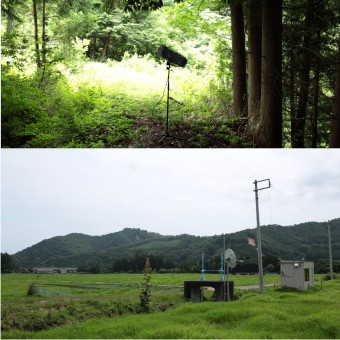Radioactive Live Soundscape Sustainable Communication Design by Hill Hiroki Kobayashi |
Home > |
 |
|
||||
| DESIGN DETAILS | |||||
| DESIGN NAME: Radioactive Live Soundscape PRIMARY FUNCTION: Sustainable Communication Design INSPIRATION: According to the Chernobyl nuclear disaster report of the IAEA, it is academically and socially important to conduct ecological studies concerning the levels and effects of radiation exposure on wild animal populations over several generations. To understand the effects of the nuclear accident, long-term and wide-range monitoring of the effects of nuclear radiation on the animals is required because there is little evidence of the direct effects of radioactivity on the wildlife in Fukushima. UNIQUE PROPERTIES / PROJECT DESCRIPTION: A microphone has been placed at the entrance to a forest that is 10 kilometers away from the Fukushima Daiichi Nuclear Power Plant. This microphone allows us to hear, in real time, the soundscape through the web site coming from this location (37, 28, 04.3, N, 140, 55, 27.5, E), which is in a restricted area due to its extremely high levels of radiation. This project aims to watch over those that will come to an end in the near future and the new lives that appearing after humans left the area. OPERATION / FLOW / INTERACTION: Acoustic ecology data have been used for various types of soundscape investigations. Counting sounds in the soundscape is considered an effective method in ecology studies and offers comparative data for human caused impacts on the environment. We constructed one Acoustic Ecology Data Transmitter in Exclusion Zone (Namie, Fukushima, Japan), 10 km from Fukushima Daiichi Nuclear Power Plant. It aims to transmit and store a live stream of sound from an unmanned remote sensing station in the area. PROJECT DURATION AND LOCATION: This project aims to operate the system for 24 h in a day and 365 days a year. It started with a year of literature search (2011), fundraising with government approval (2012–2014), and the installation of a transmitter station with satellite Internet (2015). The final construction was completed by the end of March in 2016. It is an Overall Winner work, 11th Arte Laguna Prize exhibition, Venice, Italia, 2017 and a Winner work for Excellent Communications Design, German Design Award 2018. FITS BEST INTO CATEGORY: Social Design |
PRODUCTION / REALIZATION TECHNOLOGY: This project aims to collect, share, and analyze the soundscape data in the exclusion zone by performing the following activities: (1) Distributing these sound data in the exclusion zone to the public via the internet, in order to make the live sounds in the area publicly available for listening in real time and (2) distributing these sound data to the public via the Internet for 24 h in a day and 365 days a year. SPECIFICATIONS / TECHNICAL PROPERTIES: We developed a Live Sound System and a Streaming/Archiving System. The technical operational testing notes of the Live Sound System can be found in our previous study. Saito, K. et al. Utilizing the Cyberforest live sound system with social media to remotely conduct woodland bird censuses in Central Japan. Ambio 44, 572-583, doi:10.1007/s13280-0 TAGS: Communication Design, Soundscape, Fukushima exclusion zone, Live Streaming, Sustainability, Wildlife, Acoustic Ecology, Recording, RESEARCH ABSTRACT: Following the Fukushima Nuclear Power Plant disaster, the journal Nature pointed to the importance of ecological studies being initiated at the very beginning of a disaster. Ishida reported that it is essential to place automatic recording devices (e.g., portable digital recorders) at over 500 locations to collect and analyze the vocalizations of target wild animals. To support ongoing ecological research, a new monitoring tool is now being developed by the author. CHALLENGE: For monitoring such species, counting the recorded calls of animals is considered an effective method. However, it is difficult to use information devices in the exclusion zone as these areas do not have infrastructure services. It is necessary to develop a monitoring system capable of operating years to ensure long-term stability under unmanned conditions. We expect this work to prove useful for studies on topics, which include radioecology and the emerging dialects for future observations. ADDED DATE: 2017-08-17 23:27:52 TEAM MEMBERS (1) : Hill Hiroki Kobayashi, Hiromi Kudo and their laboratory members IMAGE CREDITS: Hill Hiroki Kobayashi, 2017. PATENTS/COPYRIGHTS: Copyrights belong to Hill Hiroki Kobayashi, 2016. |
||||
| Visit the following page to learn more: http://radioactivelivesoundscape.net/ | |||||
| AWARD DETAILS | |
 |
Radioactive Live Soundscape Sustainable Communication Design by Hill Hiroki Kobayashi is Runner-up for A' Design Award in Social Design Category, 2017 - 2018.· Read the interview with designer Hill Hiroki Kobayashi for design Radioactive Live Soundscape here.· Press Members: Login or Register to request an exclusive interview with Hill Hiroki Kobayashi. · Click here to register inorder to view the profile and other works by Hill Hiroki Kobayashi. |
| SOCIAL |
| + Add to Likes / Favorites | Send to My Email | Comment | Testimonials |








